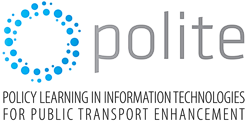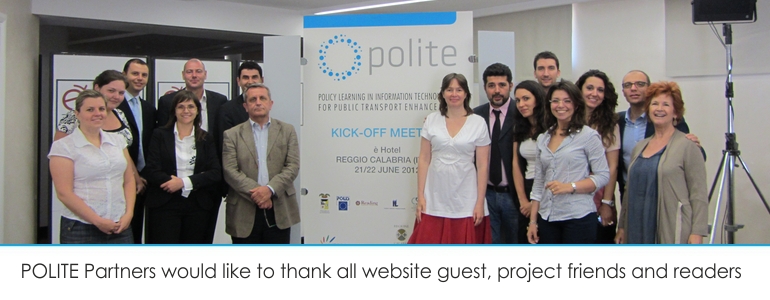INTERREG IVC identify a good practice as:
“an initiative (eg methodologies, projects, processes and techniques) undertaken in one of the programme’s thematic priorities which has already proved successful and which has the potential to be transferred to a different geographic area. Proved successful is where the good practice has already provided tangible and measurable results in achieving a specific objective.” [Ref: www.interreg4c.eu - Glossary]
What is a POLITE Good Practice?
The target for POLITE is to identify 30 Good Practices and therefore it is necessary to identify what project partners define as a Good Practice.
POLITE partners identified a detailed list of 54 measures / scenarios which comprehensively cover the overall objective of POLITE project. Good Practice sites are likely to have implemented a system / systems or services each of which are likely to cover a range of the 54 detailed measures. Examples of systems would be a Real Time Passenger Information system, a Smart ticketing payment system or public transport priority at traffic signals. Each separate system / service, where they are clearly distinct and could be implemented on their own can be considered to be a POLITE Good Practice Measure.
POLITE is focused on the application of Information Technologies for Public Transport and hence the target of 30 Good Practices identified should be technology based. However, through the course of the project, non ITS based Good Practices may be identified which relate to a site identified to provide and ITS Good Practice and these should also be collated as additional Good Practices. An example of a non ITS Good Practice is Reading’s Premier Bus route network which has distinctly coloured buses for each route which enables passengers to identify ‘their’ bus very easily.
Process of Selecting Good Practices in POLITE
The classification of GPsconsists of five following groups:
- Public Transport and/or Multimodal Information Systems
- Bus Automatic Vehicle Location (AVL)
- Real Time Passenger Information Systems (RTPI)
- Real Time Traveller Information Systems (RTTIS), bus stops, on bus, in public locations, on web, on mobile devices
- Journey Planning Systems (single mode / multimodal)
- Public Transport Fleet Management Systems
- Public Transport Interchanges
- Public Transport Priority Systems
- Bus priority at signals
- Bus Gates / Bus Lanes
- Enforcement systems eg bus lane enforcement
- Access controls
- Public Transport Payment Systems
- Pre Pay Contactless Smart Cards
- Innovative Incentive Schemes.







